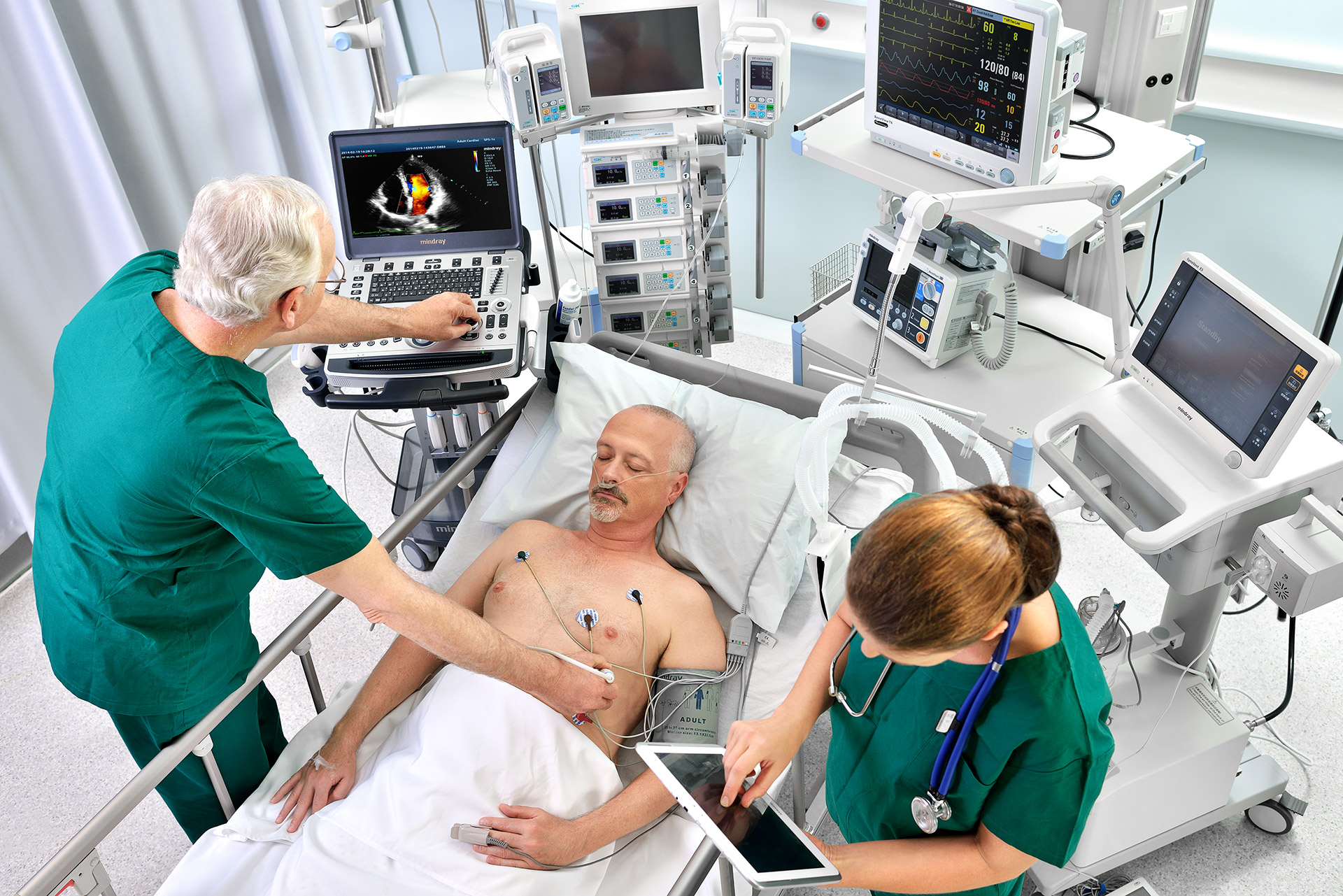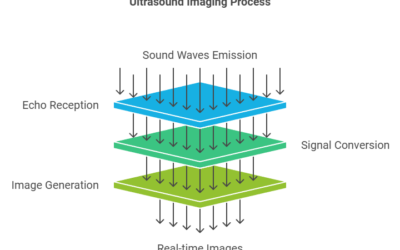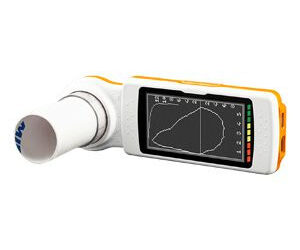Introduction to Portable Ultrasound Machines
Portable ultrasound machines are designed to be compact, lightweight, and easily transportable. They consist of several key components:
- Transducer/Probe: The transducer is the heart of the ultrasound machine. It emits high-frequency sound waves into the body and receives the echoes that are reflected back. These echoes are then converted into electrical signals to produce images. Transducers come in various shapes and sizes, each suited for different types of examinations.
- Central Processing Unit (CPU): The CPU processes the signals received from the transducer and constructs the ultrasound images. It houses the system’s software, controls the image display, and manages data storage.
- Display Screen: Portable ultrasound machines feature high-resolution screens that display real-time images. Modern units often include touchscreen capabilities for easy navigation and control.
- Power Source: These machines are designed to operate on battery power, allowing for mobility and use in remote or emergency settings. Battery life varies, but many units are equipped with long-lasting, rechargeable batteries.
- Connectivity Options: To facilitate data sharing and integration with other medical systems, portable ultrasound machines often include wireless and wired connectivity options such as Wi-Fi, Bluetooth, USB ports, and HDMI outputs.
Functionality and Imaging Modes
Portable ultrasound machines utilize several imaging modes to provide detailed diagnostic information:
- B-Mode (Brightness Mode): The most common imaging mode, B-Mode produces two-dimensional grayscale images. It is used to visualize internal organs, tissues, and fetal development.
- M-Mode (Motion Mode): M-Mode captures moving images and is primarily used in cardiology to assess heart function and motion.
- Doppler Mode: This mode measures the flow of blood through vessels, providing valuable information about blood velocity and direction. Doppler ultrasound is crucial for diagnosing vascular conditions.
- Color Doppler: An extension of Doppler mode, color Doppler adds color to the images to represent blood flow direction and speed, enhancing the visualization of blood vessels.
- Power Doppler: This mode offers more sensitive detection of blood flow compared to traditional Doppler, making it useful for detecting low-velocity blood flow.
- 3D and 4D Imaging: Advanced portable ultrasound machines can generate three-dimensional images, with 4D adding real-time motion to the 3D images. These modes are especially useful in obstetrics and gynecology.
Applications of Portable Ultrasound Machines
Portable ultrasound machines are used across various medical specialties due to their versatility and ease of use. Key applications include:
- Emergency Medicine: In emergency settings, portable ultrasound machines are invaluable for rapid assessment of trauma patients, guiding procedures such as central line placement, and diagnosing conditions like pneumothorax or cardiac tamponade.
- Critical Care: In the ICU, these devices assist in monitoring hemodynamic status, guiding fluid management, and assessing cardiac function.
- Obstetrics and Gynecology: Portable ultrasound is widely used for prenatal care, including fetal monitoring, assessing fetal development, and diagnosing ectopic pregnancies.
- Cardiology: Cardiologists use portable ultrasound for echocardiography to evaluate heart function, detect valvular diseases, and monitor patients with heart failure.
- Musculoskeletal: These machines help in diagnosing soft tissue injuries, guiding joint injections, and evaluating musculoskeletal disorders.
- Primary Care: Primary care physicians utilize portable ultrasound for routine examinations, such as abdominal scans, thyroid assessments, and detecting gallstones.
- Veterinary Medicine: Portable ultrasound machines are also used in veterinary practices for animal diagnostics and reproductive monitoring.
Clinical Impact
Emergency Medicine
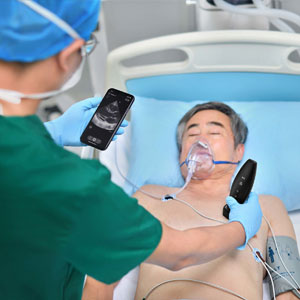 In emergency medicine, the rapid and accurate assessment of patients is crucial. Portable ultrasound machines have become indispensable in this setting, providing immediate diagnostic information that can guide treatment decisions. A case study involving a busy urban emergency department demonstrated that the use of portable ultrasound significantly reduced the time to diagnosis for conditions such as abdominal aortic aneurysm, internal bleeding, and cardiac tamponade. The ability to perform bedside imaging allowed for quicker triage and initiation of appropriate interventions, ultimately improving patient outcomes.
In emergency medicine, the rapid and accurate assessment of patients is crucial. Portable ultrasound machines have become indispensable in this setting, providing immediate diagnostic information that can guide treatment decisions. A case study involving a busy urban emergency department demonstrated that the use of portable ultrasound significantly reduced the time to diagnosis for conditions such as abdominal aortic aneurysm, internal bleeding, and cardiac tamponade. The ability to perform bedside imaging allowed for quicker triage and initiation of appropriate interventions, ultimately improving patient outcomes.
Rural and Remote Healthcare
Portable ultrasound machines have made a significant impact on healthcare delivery in rural and remote areas. In regions with limited access to advanced medical facilities, these devices enable healthcare providers to perform critical diagnostic procedures without needing to transfer patients to distant hospitals. A study conducted in rural India showed that the introduction of portable ultrasound machines greatly enhanced the ability to diagnose and monitor conditions like tuberculosis, pneumonia, and obstetric complications. This not only improved the quality of care but also reduced the healthcare costs associated with patient transfers and delayed treatments.
Critical Care Units
In critical care units (ICUs), portable ultrasound machines are used extensively for monitoring and diagnostic purposes. Their role in guiding invasive procedures such as central venous catheter placement, thoracentesis, and paracentesis has been well documented. A multicenter study across several ICUs found that the use of portable ultrasound reduced the complication rates associated with these procedures by providing real-time visualization of anatomical structures. Additionally, the ability to assess cardiac function, fluid status, and lung pathology at the bedside has enhanced the management of critically ill patients, leading to better clinical outcomes.
Related: TE AIR Ultrasound
Training and Education
Medical Education
The integration of portable ultrasound machines into medical education curricula has transformed the training of healthcare professionals. Medical schools and residency programs are increasingly incorporating ultrasound training to ensure that new graduates are proficient in this essential skill. A study at a major teaching hospital revealed that incorporating ultrasound training into the medical curriculum improved students’ understanding of anatomy, physiology, and pathophysiology. Hands-on training with portable ultrasound machines enhanced their diagnostic abilities and confidence in performing bedside assessments.
Continuing Medical Education (CME)
For practicing clinicians, continuing medical education (CME) is vital to keep abreast of technological advancements and clinical practices. Portable ultrasound training courses and workshops have become popular components of CME programs. These courses offer hands-on experience and practical knowledge, enabling clinicians to integrate portable ultrasound into their daily practice effectively. A survey of CME participants highlighted that those who completed portable ultrasound training reported increased usage and improved diagnostic accuracy in their practice, reflecting the importance of ongoing education.
Point-of-Care Ultrasound (POCUS) Certification
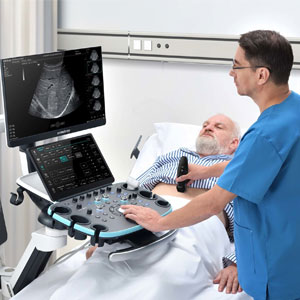 The growing use of portable ultrasound machines has led to the development of certification programs for point-of-care ultrasound (POCUS). Certification ensures that practitioners possess the necessary skills and knowledge to use ultrasound effectively. Several professional organizations, including the American College of Emergency Physicians (ACEP) and the Society of Hospital Medicine (SHM), offer POCUS certification programs. These programs typically include didactic instruction, hands-on training, and competency assessments, ensuring that certified practitioners can provide high-quality ultrasound examinations.
The growing use of portable ultrasound machines has led to the development of certification programs for point-of-care ultrasound (POCUS). Certification ensures that practitioners possess the necessary skills and knowledge to use ultrasound effectively. Several professional organizations, including the American College of Emergency Physicians (ACEP) and the Society of Hospital Medicine (SHM), offer POCUS certification programs. These programs typically include didactic instruction, hands-on training, and competency assessments, ensuring that certified practitioners can provide high-quality ultrasound examinations.
Technological Innovations
Enhanced Image Resolution
One of the most significant advancements in portable ultrasound technology is the improvement in image resolution. Modern portable ultrasound machines now offer high-definition imaging capabilities that were previously only available in larger, stationary units. This enhanced image quality allows for more accurate diagnoses and better visualization of small or subtle anatomical details. Innovations in transducer technology, such as the development of high-frequency linear probes, have further improved the clarity and detail of ultrasound images.
AI-Powered Diagnostic Tools
Artificial intelligence (AI) is playing an increasingly important role in portable ultrasound technology. AI-powered diagnostic tools can assist clinicians by automatically identifying anatomical structures, detecting abnormalities, and suggesting possible diagnoses. These tools use machine learning algorithms trained on vast datasets to recognize patterns and make accurate predictions. A study on the use of AI in portable ultrasound machines found that AI-assisted diagnostics improved the accuracy and speed of image interpretation, particularly for less experienced operators.
Wireless and Cloud Connectivity
The integration of wireless and cloud connectivity features in portable ultrasound machines has enhanced their functionality and usability. These features enable the seamless transfer of ultrasound images and data to electronic health records (EHRs) and other medical systems. Cloud-based storage allows for easy access to patient images and reports from any location, facilitating remote consultations and telemedicine. Additionally, wireless connectivity supports real-time collaboration between clinicians, improving diagnostic accuracy and patient care.
Regulatory and Safety Considerations
Regulatory Approvals
Portable ultrasound machines are subject to regulatory approvals to ensure their safety and efficacy. In the United States, the Food and Drug Administration (FDA) regulates medical devices, including portable ultrasound machines. Manufacturers must obtain FDA clearance or approval before marketing their devices. The regulatory process involves rigorous testing and evaluation of the device’s performance, safety, and compliance with established standards. Similar regulatory bodies exist in other countries, such as the European Medicines Agency (EMA) in Europe and the Therapeutic Goods Administration (TGA) in Australia.
Safety Standards
Ensuring the safety of portable ultrasound machines involves adherence to established safety standards. These standards cover various aspects, including electrical safety, electromagnetic compatibility, and acoustic output. The International Electrotechnical Commission (IEC) and the American Institute of Ultrasound in Medicine (AIUM) have developed guidelines and standards that manufacturers must follow. Compliance with these standards helps prevent potential risks associated with the use of ultrasound, such as tissue heating and mechanical injury.
User Training and Safety
Proper training and education for users of portable ultrasound machines are crucial for ensuring patient safety. Operators must be knowledgeable about the principles of ultrasound physics, image acquisition techniques, and interpretation of findings. Adequate training helps minimize operator-dependent errors and enhances the overall quality of care. Institutions and healthcare providers should establish protocols and guidelines for the safe and effective use of portable ultrasound machines, including regular maintenance and quality assurance checks.
Economic and Health System Impacts
Cost-Effectiveness
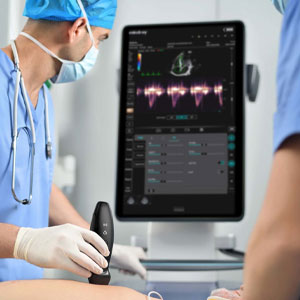 The cost-effectiveness of portable ultrasound machines is a significant advantage for healthcare systems. These devices are generally more affordable than traditional, larger ultrasound systems, making them accessible to a broader range of healthcare providers. The lower cost of portable ultrasound machines reduces the financial burden on healthcare facilities, particularly in low-resource settings. Additionally, the ability to perform point-of-care diagnostics can lead to cost savings by reducing the need for additional imaging studies and hospital admissions.
The cost-effectiveness of portable ultrasound machines is a significant advantage for healthcare systems. These devices are generally more affordable than traditional, larger ultrasound systems, making them accessible to a broader range of healthcare providers. The lower cost of portable ultrasound machines reduces the financial burden on healthcare facilities, particularly in low-resource settings. Additionally, the ability to perform point-of-care diagnostics can lead to cost savings by reducing the need for additional imaging studies and hospital admissions.
Improved Resource Utilization
Portable ultrasound machines contribute to improved resource utilization within healthcare systems. By providing immediate diagnostic information at the point of care, these devices reduce the reliance on centralized imaging facilities and radiology departments. This decentralization of diagnostic services helps streamline patient care, reduces wait times, and enhances overall efficiency. A study conducted in a large hospital system demonstrated that the use of portable ultrasound machines in the emergency department led to a significant reduction in the length of stay for patients with certain conditions.
Access to Care
One of the most profound impacts of portable ultrasound machines is their ability to improve access to care, especially in underserved and remote areas. These devices enable healthcare providers to deliver high-quality diagnostic services to populations that may otherwise have limited access to advanced medical imaging. By bringing diagnostic capabilities closer to patients, portable ultrasound machines help bridge the gap in healthcare disparities and ensure timely and accurate diagnoses for all individuals, regardless of their geographic location.
Related: Mindray TE7 MAX
Comparative Analysis with Traditional Ultrasound Systems
Size and Portability
The primary difference between portable ultrasound machines and traditional ultrasound systems is size and portability. Traditional ultrasound systems are typically large, stationary units that require dedicated space and infrastructure. In contrast, portable ultrasound machines are compact and lightweight, designed for easy transport and use in various settings. This portability makes them ideal for bedside imaging, emergency situations, and fieldwork, where traditional systems may not be practical.
Image Quality and Capabilities
While portable ultrasound machines have made significant advancements in image quality, traditional ultrasound systems still tend to offer superior resolution and advanced imaging capabilities. High-end stationary systems can provide more detailed images and support specialized imaging modalities, such as contrast-enhanced ultrasound and elastography. However, the gap in image quality is narrowing as portable ultrasound technology continues to improve, making these devices increasingly competitive with their larger counterparts.
Cost and Accessibility
Cost is another critical factor that distinguishes portable ultrasound machines from traditional systems. Portable devices are generally more affordable, making them accessible to a broader range of healthcare providers and facilities. This affordability is particularly important in resource-limited settings, where the cost of traditional ultrasound systems may be prohibitive. The lower cost of portable ultrasound machines facilitates their widespread adoption and integration into diverse healthcare environments.
Workflow and Efficiency
Portable ultrasound machines offer significant advantages in terms of workflow and efficiency. Their ability to provide immediate, point-of-care diagnostics streamlines patient care and reduces the need for additional imaging studies and patient transfers. Traditional ultrasound systems, while offering high-quality imaging, often require scheduling, transport, and coordination with radiology departments, which can introduce delays in the diagnostic process. The efficiency of portable ultrasound machines enhances clinical workflows and supports more timely decision-making.
Integration with Other Medical Technologies
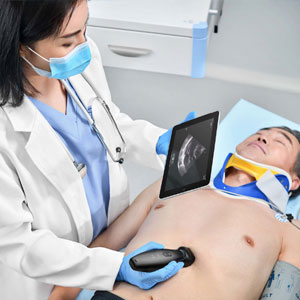 Telemedicine
Telemedicine
The integration of portable ultrasound machines with telemedicine platforms represents a significant advancement in healthcare delivery. Telemedicine allows for remote consultations and real-time collaboration between clinicians, bridging geographic barriers and improving access to specialist care. Portable ultrasound machines equipped with wireless connectivity can transmit images and data to remote experts for interpretation and guidance. This integration enhances diagnostic accuracy and supports better clinical decision-making, particularly in rural and underserved areas.
Electronic Health Records (EHRs)
The seamless integration of portable ultrasound machines with electronic health records (EHRs) enhances the efficiency and continuity of patient care. Portable devices with wireless and cloud connectivity can automatically upload images and reports to EHR systems, ensuring that all relevant diagnostic information is readily available to the healthcare team. This integration facilitates comprehensive patient management, reduces documentation errors, and supports coordinated care across different healthcare providers and settings.
Point-of-Care Testing (POCT)
Portable ultrasound machines complement other point-of-care testing (POCT) technologies, creating a more comprehensive diagnostic toolkit at the bedside. Combining ultrasound imaging with POCT devices, such as blood analyzers and rapid diagnostic tests, enables a holistic assessment of the patient’s condition in real-time. This integrated approach supports more accurate and timely diagnoses, improves patient outcomes, and enhances the overall quality of care.
By integrating portable ultrasound machines with these advanced medical technologies, healthcare providers can leverage the strengths of each tool to deliver more effective and efficient patient care. As these technologies continue to evolve, the potential for enhanced diagnostic capabilities and improved patient outcomes will continue to grow.
Related: Mindray Z.ONE Pro
Advantages of Portable Ultrasound Machines
Portable ultrasound machines offer several advantages that make them an attractive option for medical practitioners:
- Portability and Convenience: Their compact size and battery-operated design allow for use in various settings, including remote locations, ambulances, and patient homes. This enhances the accessibility of diagnostic imaging.
- Cost-Effectiveness: Compared to traditional, larger ultrasound machines, portable units are generally more affordable, reducing the financial burden on healthcare facilities.
- Real-Time Imaging: The ability to provide immediate imaging results allows for quick clinical decisions and timely interventions, improving patient outcomes.
- Reduced Patient Movement: Portable ultrasound machines can be brought to the patient’s bedside, minimizing the need for patient transport and reducing the risk of complications in critically ill patients.
- Versatility: With multiple imaging modes and a wide range of applications, these machines can be used for various diagnostic purposes, making them a versatile tool in any medical practice.
Technological Advancements
Recent advancements in portable ultrasound technology have further enhanced their capabilities and applications:
Artificial Intelligence (AI) Integration
AI algorithms are being integrated into portable ultrasound machines to assist with image interpretation, improving diagnostic accuracy and reducing operator dependency. These algorithms can automatically detect and highlight abnormalities, guide probe placement, and suggest measurements.
 Wireless Connectivity
Wireless Connectivity
The inclusion of wireless connectivity options enables seamless data transfer and integration with electronic health records (EHRs). This facilitates remote consultations and telemedicine, allowing specialists to review images and provide recommendations from different locations.
Enhanced Imaging Quality
Advancements in transducer technology and image processing software have led to significant improvements in image quality. Higher resolution and better contrast allow for more detailed and accurate diagnoses.
Miniaturization
Continued miniaturization of components has made portable ultrasound machines even smaller and lighter without compromising performance. This enhances their usability in various clinical settings, including field hospitals and disaster response scenarios.
User-Friendly Interfaces
Modern portable ultrasound machines feature intuitive, user-friendly interfaces with touchscreens and customizable settings. This makes them easier to use, even for clinicians with limited ultrasound training.
Challenges and Limitations
While portable ultrasound machines offer numerous benefits, they also present certain challenges and limitations:
- Operator Dependency: The quality of ultrasound imaging and interpretation is highly dependent on the skill and experience of the operator. Inadequate training can lead to misdiagnoses.
- Limited Field of View: Portable ultrasound machines may have a smaller field of view compared to larger, stationary units, which can limit their diagnostic capabilities in certain cases.
- Battery Life: While designed for portability, the battery life of these machines can be a limiting factor, especially in remote or resource-limited settings. Regular recharging and battery management are essential.
- Image Quality: Although advancements have been made, portable ultrasound machines may still produce lower image quality compared to high-end, stationary systems. This can affect the accuracy of certain diagnostic evaluations.
- Cost of Accessories: While the machines themselves are relatively affordable, the cost of transducers, maintenance, and software updates can add up over time.
Future Prospects
The future of portable ultrasound machines looks promising, with ongoing research and development aimed at overcoming current limitations and expanding their capabilities:
Advanced AI and Machine Learning
Further integration of AI and machine learning algorithms will enhance the diagnostic accuracy and usability of portable ultrasound machines. These technologies will continue to evolve, providing more robust decision support and automated analysis.
Improved Battery Technology
Advancements in battery technology will lead to longer-lasting, faster-charging batteries, increasing the operational time and reliability of portable ultrasound machines in various settings.
Expanded Applications
Research is exploring new applications for portable ultrasound, including its use in monitoring chronic diseases, guiding minimally invasive surgeries, and even in space medicine for astronaut health monitoring.
Global Health Impact
Portable ultrasound machines have the potential to make a significant impact on global health by providing accessible diagnostic tools in underserved and remote areas. Initiatives to train healthcare workers in ultrasound use and improve affordability will be crucial in realizing this potential.
Telemedicine Integration
The integration of portable ultrasound machines with telemedicine platforms will enable remote diagnostics and consultations, bridging the gap between patients and specialists and improving access to quality healthcare.









